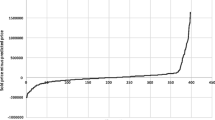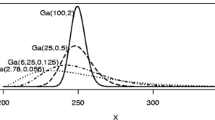Abstract
Due to the heterogeneous nature of real estate assets, housing market is characterized by a sequential search and seller’s optimal strategies. This paper provides a side-by-side performance comparison of the two competing stopping rules (i.e, the reservation rule and the number rule) in the housing market. It demonstrates that the selling strategies by these two stopping rules are not mutually exclusive, and the optimal choice of the two strategies varies over market conditions. Our analyses reveal clear evidence that no strategy consistently outperforms the other under all market conditions. Therefore, a single selling strategy is likely to result in suboptimal selling outcomes, and the widely-used reservation rule in academic research is likely to result in biased findings. Furthermore, we identify the explicit impact of several supply and demand factors on the optimal trading outcome and provide rich insights into optimal selling strategies in the housing market.







Similar content being viewed by others
Notes
Due to the heterogeneous real estate assets, some recent studies focus on market participants’ search and bargaining (e.g. Bian et al. 2018; Zillante et al. 2019), and others study the information communication problem between real estate agents and home sellers, in which the agent has private information that is valuable to the home seller (e.g. Xie 2019, and Liu and Xie 2020).
See the proof in Appendix A.
See the proof in Appendix B.
See Ross (2002, p275)
See the proof in Appendix C.
References
Arnold, M. (1999). Search, bargaining and optimal asking prices. Real Estate Economics, 27, 453–481.
Arnold, M., & Lippman, S. (1995). Selecting a selling institution: auction versus sequential search. Economic Inquiry, 33, 1–23.
Barron, J. (1975). Search in the labor market and the duration of unemployment: some empirical evidence. American Economic Review, 65, 934–942.
Bian, X., Turnbull, G., & Waller, B. (2017). Client externality effects of agents selling their own properties. Journal of Real Estate Finance and Economics, 54(2), 139–164.
Bian, X., Lin, Z., & Liu, Y. (2018). House price, loan-to-value ratio and credit risk. Journal of Banking and Finance, 92, 1–12.
Bond, S., Hwang, S., Lin, Z., & Vandell, K. (2007). Marketing period risk in a portfolio context: theory and empirical estimates from the UK commercial real estate market? Journal of Real Estate Finance and Economics, 34, 447–461.
Bulow, J., & Klemperer, P. (1996). Auctions versus negotiations. American Economic Review, 86(1), 180–194.
Cheng, P., Lin, Z., & Liu, Y. (2008). A model of time-on-market and real estate price under sequential search with recall. Real Estate Economics, 36, 813–843.
Cheng, P., Lin, Z., & Liu, Y. (2013). Liquidity risk of private assets: evidence from real estate markets. The Financial Review, 48, 671–696.
Cheng, P., Lin, Z., Liu, Y., & Seiler, M. (2015). The benefit of search in housing markets. Journal of Real Estate Research, 37, 597–622.
Gan, Q. (2013). Optimal selling mechanism, auction discounts and time on market. Real Estate Economics, 41(2), 347–383.
Haurin, D. (1988). The duration of marketing time of residential housing. AREUEA Journal, 16, 396–410.
He, X., Lin, Z., Liu, Y., & Seilr, M. (2020). Search benefit in housing markets: an inverted U-Shaped price and TOM relation. Real Estate Economics, forthcoming.
Holmes, C, & Xie, J. (2018). Distortion in real estate transactions with out-of-state participants. The Journal of Real Estate Finance and Economic, 57, 592–617.
Horowitz, J. (1992). The role of the listing price in housing markets: theory and an econometric model. Journal of Applied Economics, 7, 115–129.
Johnson, K., Lin, Z., & Xie, J. (2015). Dual agent distortions in real estate transactions. Real Estate Economics, 43(2), 507–536.
Lin, Z., & Liu, Y. (2008). Real estate returns and risk with heterogeneous investors. Real Estate Economics, 36, 753–776.
Lin, Z., & Vandell, K. (2007). Illiquidity and pricing biases in the real estate market. Real Estate Economics, 35, 291–330.
Lippman, S., & McCall, J. (1986). An Operational Measure of Liquidity. American Economic Review, 76, 43–55.
Liu, P., & Xie, J. (2020). Optimal contract design in residential brokerage. Real Estate Economics, forthcoming.
Leung, C., & Tse, C. (2017). Flipping in the housing market. Journal of Economic Dynamics & Control, 76, 232–263.
Leung, C., Leong, Y., & Chan, I. (2002). TOM: why isn’t price enough? International Real Estate Review, 5, 91–115.
McCall, J. (1970). Economics of information and job search. Quarterly Journal of Economics, 84(1), 113–126.
Miceli, T. (1989). The optimal duration of real estate listing contracts. AREUEA Journal, 17, 267–277.
Milgrom, P. (1987). . In T. Bewley (Ed.) Auction theory, advances in economic theory: fifth world congress (pp. 1–32). London: Cambridge University Press.
Mortensen, D. (1970). Job search, the duration of unemployment, and the Phillips curve. American Economic Review, 60(5), 847–862.
Mortensen, D. (1986). Job search and labor market analysis. Handbook of labor economics North Holland, Amsterdam (pp. 849–920).
Read, C. (1988). Price strategies for idiosyncratic goods: the case of housing. AREUEA Journal, 16, 379–395.
Ross, S. (2002). A first course in probability, 6th edn. Upper Saddle River: Prentice Hall.
Scofield, D., & Xie, J. (2019). The effect of dual brokerage on commercial real estate prices: evidence from office sales in the U.S. Journal of Real Estate Research, 41(3), 347–378.
Sirmans, C., Turnbull, G., & Dombrow, J. (1995). Quick house sales: Investor mistake or luck?, Journal of housing economics, 230–243.
Stigler, G. (1962). Information in the labor market. Journal of Political Economy, 70, 94–105.
Thomas, C., & Wilson, B. (2002). A comparison of auctions and multilateral negotiations. RAND Journal of Economics, 33(1), 140–155.
Wheaton, W. (1990). Vacancy, search, and prices in a housing market matching model. Journal of Political Economy, 98(6), 1270–1292.
Whipple, D. (1973). A generalized theory of job search. Journal of Political Economy, 81, 1170–1188.
Xie, J. (2018). Who is “misleading” whom in real estate transactions? Real Estate Economics, 46(3), 527–558.
Xie, J. (2019). Optimal selling strategy of residential real estate. Journal of Real Estate Finance and Economics, 59(3), 461–489.
Yinger, J. (1981). A search model of real estate broker behavior. American Economic Review, 71, 591–605.
Zillante, A., Read, D., & Seiler, M. (2019). Using prospect theory to better understand the impact of uncertainty on real estate negotiations. Journal of Real Estate Research, 41(1), 75–105.
Author information
Authors and Affiliations
Corresponding author
Additional information
Publisher’s Note
Springer Nature remains neutral with regard to jurisdictional claims in published maps and institutional affiliations.
Appendices
Appendix: I
Given that \(\eta =(\overline {p}-R^{*})/(\overline {p}-\underline {p})\) in Eq. 6, we can obtain,
In addition, we have,
Since we have,
and,
From Eqs. 6, 8, 9, 30, 31 and 32, we can therefore rewrite Eqs. 33 and 34 as Eqs. 10 and 11.
Appendix: II
Since we have
From Eqs. 6, 8, and 32, we can have,
From Eq. 10, we can further have,
Appendix: III
Since we have,
Substituting Eq. 38 into Eq. 23 and simplifying it will result in Eq. 24. This derivation is consistent with Eq. 6 to 9 in Cheng et al. (2008).
Rights and permissions
About this article
Cite this article
Cheng, P., Lin, Z. & Liu, Y. Competing Selling Strategies in the Housing Market. J Real Estate Finan Econ 63, 394–413 (2021). https://doi.org/10.1007/s11146-020-09778-1
Published:
Issue Date:
DOI: https://doi.org/10.1007/s11146-020-09778-1




